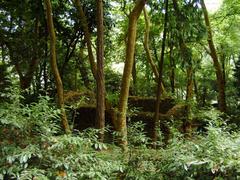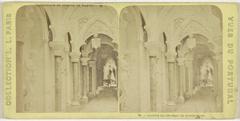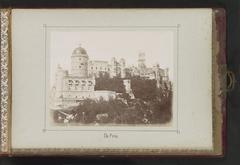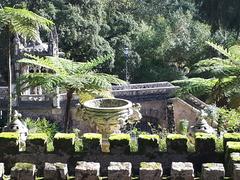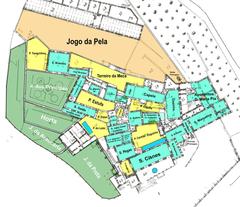Necrópole Pré-Histórica do Vale de São Martinho – Visiting Hours, Tickets, and Historical Significance in Sintra, Portugal
Date: 14/06/2025
Introduction
Nestled in the verdant hills of the Serra de Sintra, the Necrópole Pré-Histórica do Vale de São Martinho is one of Portugal’s most important prehistoric archaeological sites. Dating from the Late Neolithic to the Chalcolithic period (circa 3500–2000 BCE), this necropolis offers a fascinating window into the funerary practices, social organization, and settlement patterns of early communities in western Iberia. Its striking rock-cut tombs and menhirs exemplify the transition from hunter-gatherer groups to settled agrarian societies, marking a pivotal chapter in Portugal’s cultural heritage.
Visitors are invited to explore a landscape steeped in millennia of history, where collective burial traditions reveal complex social structures and the early emergence of metallurgy. Set against Sintra’s UNESCO-designated cultural backdrop, the Vale de São Martinho necropolis both enriches our understanding of prehistoric life and complements Sintra’s diverse historical attractions, including the Castelo dos Mouros and the Convento dos Capuchos.
The site is accessible to the public, offering free entry, guided tours, and daylight visiting hours, although the terrain is uneven and not fully accessible for all. With nearby natural parks and archaeological sites, a visit to the necropolis can be part of a broader exploration of Sintra’s rich heritage.
Table of Contents
- Introduction
- Historical Background and Archaeological Significance
- Site Layout and Architectural Features
- Archaeological Findings
- Visitor Information
- Location and Access
- Nearby Attractions and Photographic Spots
- Facilities and Amenities
- Preservation, Conservation, and Sustainability
- Educational Importance and Research Opportunities
- Community Engagement and Cultural Identity
- Contribution to Heritage Tourism
- Frequently Asked Questions (FAQ)
- Conclusion
Historical Background and Archaeological Significance
The Necrópole Pré-Histórica do Vale de São Martinho is a key prehistoric landmark, reflecting the transition of local communities from nomadic lifestyles to agriculture. Set amidst granite hills, its rock-cut tombs and stone cists reveal collective burial traditions prevalent during the Late Neolithic and Chalcolithic periods. The site’s significance is enhanced by evidence of early metallurgy and complex social structures, contributing to Sintra’s reputation as a prehistoric and cultural hub (Sintra-Portugal.com; All About Portugal).
Site Layout and Architectural Features
Tomb Types
- Rock-cut Hypogea: Chambers carved directly into the granite, accessed by narrow entrances.
- Stone Cists: Polygonal or rectangular burial boxes constructed with large stone slabs.
- Surface Markers: Menhirs and stone mounds that mark burial sites.
Construction Materials
Local granite and stone are used throughout, assembled using dry-stone techniques. Some tombs may have been originally covered with earthen mounds, which have since eroded.
Archaeological Findings
Human Remains
Excavations have uncovered the collective remains of multiple individuals, providing insight into community burial customs and the health, diet, and social organization of prehistoric Sintra (Paisagem Cultural Sintra).
Grave Goods
Artifacts found at the site include:
- Decorated pottery fragments, likely used for both practical and ritual purposes.
- Flint tools, such as blades and arrowheads, indicating advanced technological skills.
- Ornaments made from bone, shell, and stone, reflecting social identity and connections.
- Later period copper objects, marking the onset of metallurgy.
Chronological Context
The necropolis fits within the Late Neolithic and Chalcolithic timeframe. The discovery of Bell Beaker pottery in the region suggests links to broader cultural exchanges across Iberia during the 3rd millennium BCE.
Visitor Information
Visiting Hours and Tickets
- Hours: Open to the public year-round, generally from 9:00 AM to 6:00 PM. Hours may vary by season or conservation needs.
- Tickets: Entry is free. Guided tours may require advance booking.
- Access: The site is reached via the Estrada Sintra-Ericeira (EN247), near Sintra (All About Portugal).
Guided Tours and Accessibility
- Guided tours led by archaeologists or local experts are available at select times and offer valuable context.
- The terrain is uneven and can be steep, limiting accessibility for those with mobility impairments. Suitable footwear is recommended.
Practical Tips
- Bring water, sun protection, and check the weather forecast, as Sintra’s microclimate can be changeable.
- No on-site amenities; the nearest restrooms, shops, and cafes are in Sintra town.
- Photography is encouraged for personal use, but flash and drones may be restricted to protect the site.
Location and Access
By Public Transport
- Train: Lisbon’s Rossio Station provides regular trains to Sintra (approx. 40 minutes). From Sintra, taxis or rideshare services are recommended to reach the necropolis.
- Bus: Local buses serve Sintra, but the necropolis is best accessed by taxi or private transfer (Sintra Portugal Tourism).
By Car
Driving is possible, but parking near the site is limited and roads are narrow and winding.
Nearby Attractions and Photographic Spots
- Anta de Adrenunes: Another megalithic monument with dramatic stone formations.
- Tholos do Monge: A beehive-shaped prehistoric tomb.
- Castelo dos Mouros: An 8th-century Moorish castle with panoramic views.
- Convento dos Capuchos: A 16th-century Franciscan monastery in a woodland setting.
- Sintra-Cascais Natural Park: Offers hiking trails and scenic vistas.
The area is ideal for sunrise or sunset photography, capturing the granite formations in golden light.
Facilities and Amenities
- No restrooms, cafes, or shops on site.
- Nearest amenities are located in Sintra town.
- Bring all necessary supplies (water, snacks, maps).
Preservation, Conservation, and Sustainability
The site is protected under Portuguese heritage law and conservation programs address erosion, vegetation overgrowth, and urban pressures. Sustainable management balances public access with long-term preservation (All About Portugal; Paisagem Cultural Sintra).
Educational Importance and Research Opportunities
The necropolis is a vital resource for education and research in archaeology and anthropology. Artifacts and burial structures are featured in regional museums such as the Museu Arqueológico de Odrinhas, supporting interdisciplinary study and public engagement (e-cultura.pt).
Community Engagement and Cultural Identity
Community involvement is key to conserving and interpreting the site. Partnerships with local institutions and educational programs foster pride and stewardship among Sintra’s residents.
Contribution to Heritage Tourism
As part of Sintra’s UNESCO World Heritage Cultural Landscape, the necropolis adds depth to Sintra’s rich tapestry of historical sites, supporting tourism and educational outreach (patrimoniocultural.gov.pt).
Frequently Asked Questions (FAQ)
Q: What are the visiting hours?
A: Generally 9:00 AM to 6:00 PM, but hours may vary; check local sources for updates.
Q: Is there an entry fee?
A: Entry is free, though guided tours may require booking or a fee.
Q: Is the site accessible for people with reduced mobility?
A: The terrain is uneven and not fully accessible, but main viewing areas are reachable for most visitors.
Q: Are guided tours available?
A: Yes, but only at certain times. Inquire with the Sintra tourism office or official site.
Q: Can I take photographs?
A: Yes, for personal use. Commercial photography requires permission.
Conclusion
The Necrópole Pré-Histórica do Vale de São Martinho is a cornerstone of Sintra’s prehistoric heritage, offering profound insights into ancient funerary customs, social dynamics, and cultural exchange. Its enduring stone structures, evocative setting, and connections to Sintra’s broader historical landscape make it a must-visit for history enthusiasts and travelers alike. Plan your visit in advance, respect the site’s fragile environment, and make the most of nearby attractions and educational resources.
Call to Action:
For the latest updates on visiting hours, guided tours, and heritage events, consult the Sintra tourism office or the Museu Arqueológico de Odrinhas. Download the Audiala app for interactive guides, maps, and up-to-date information about Sintra’s historical sites. Embrace responsible tourism to help preserve this extraordinary glimpse into Portugal’s ancient past.


